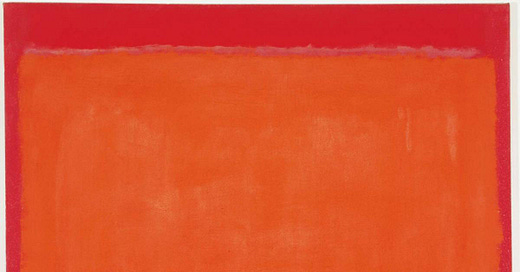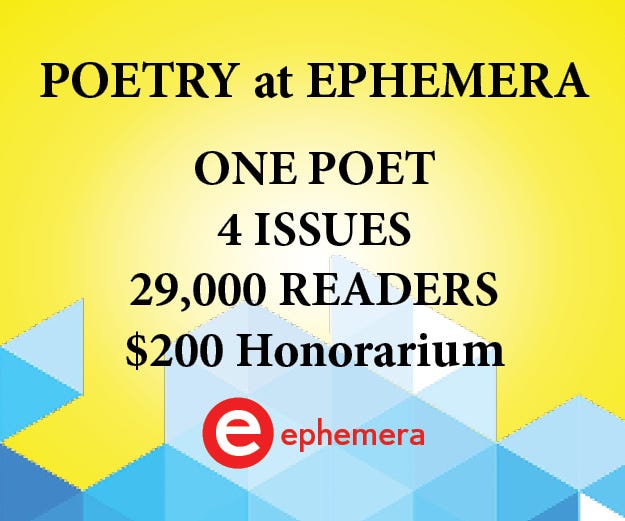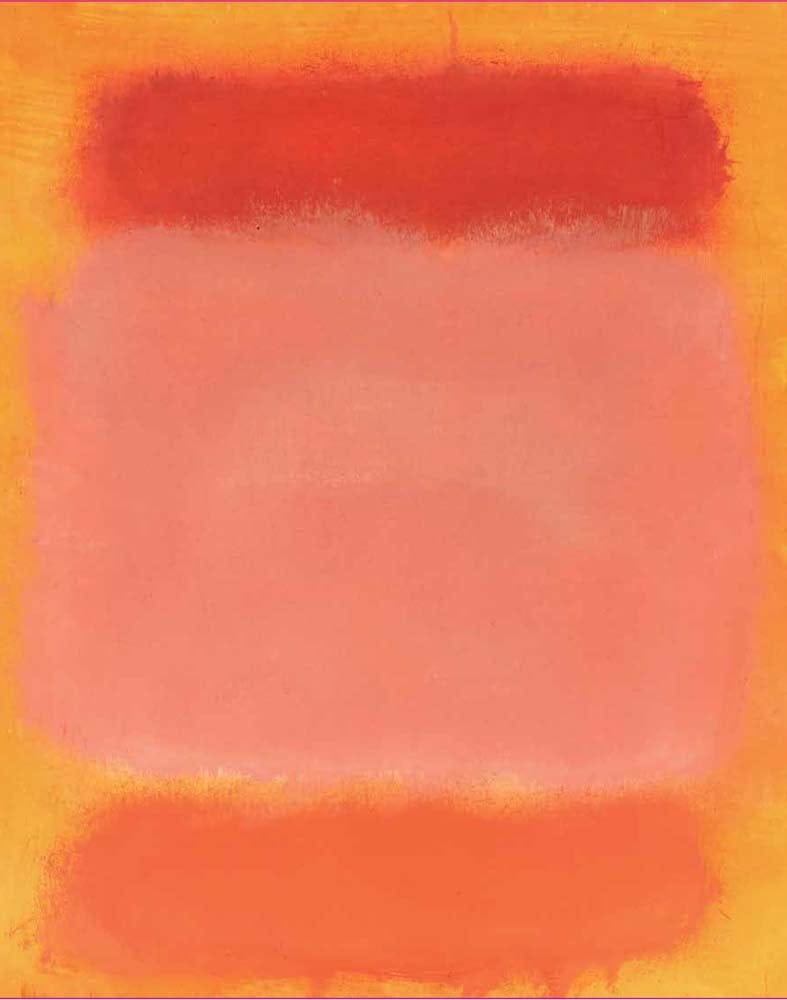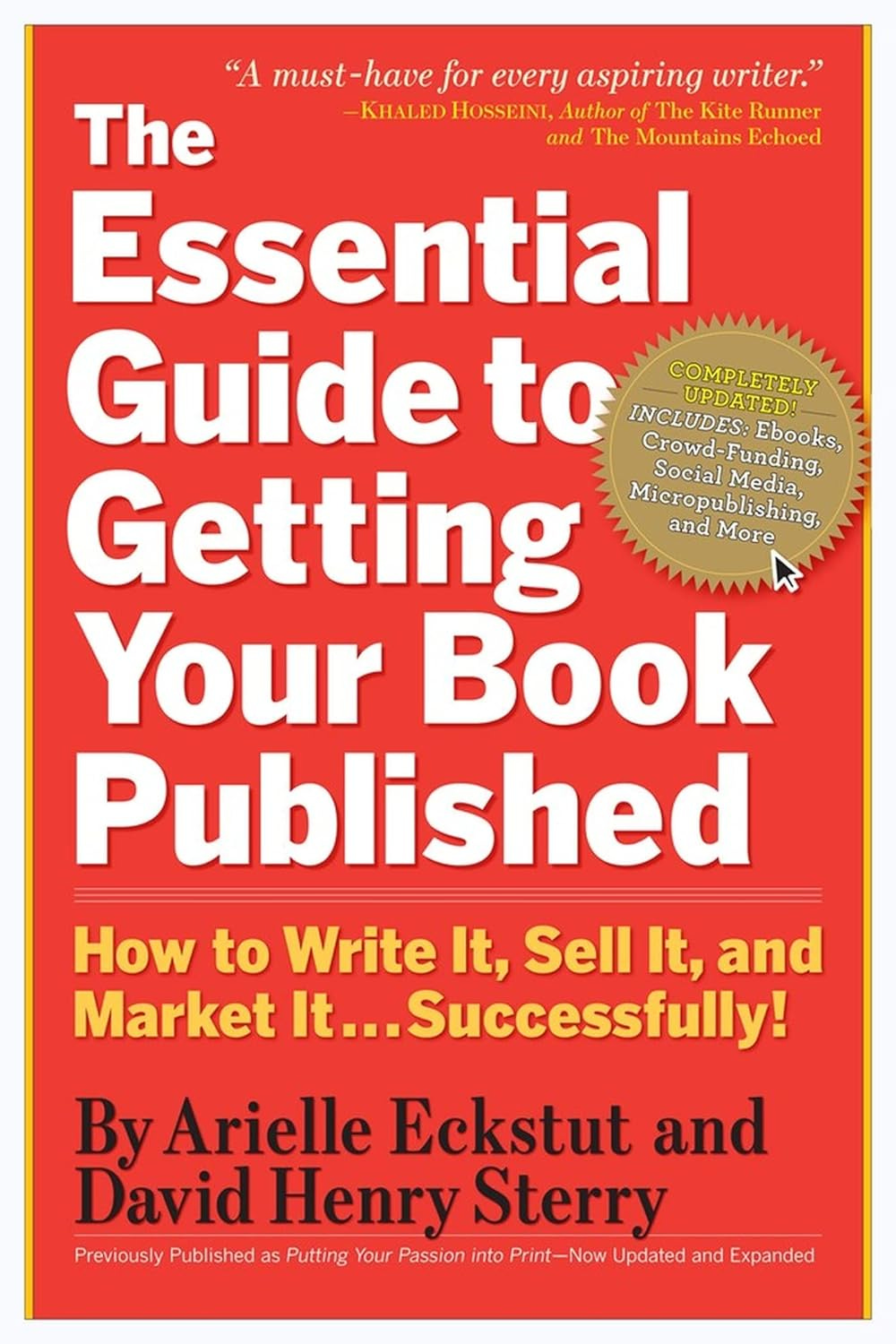Welcome to the Ephemera Newsletter free edition, Kawan-kawan! (Malay for “friends”)
Thank you to all who submitted to poetry in June for our August issues and especially to our finalist, Tara Zafft who will be the poet for the month of August! You can review her poems altogether once they publish as well as her artist statement and bio on this dedicated post on our Substack page. We thank you for checking out Tara Zafft’s work.
On to our standard content matters: Won’t you please check out last month’s free issue if you missed it.
And here are some reminders:
Monthly Invite to Submit: Submissions are in for the September issues. We look forward to reading! We are open for October now. September 1 is the deadline. If you are a paid subscriber to Ephemera, you can submit to poetry @ Ephemera for free as a membership perk! (We email you a secret link at the end of your second consecutive paid month and every month thereafter for as long as you are a paid subscriber). Free subscribers and anyone else can submit, too, with the reading fee and can submit up to 10 poems. Paying the reading fee will grant you 1-month paid access to Ephemera’s full letter. Learn more or:
In Brief…this week’s features:
Thoughts on Rothko’s “Chapel” in the Phillips Museum.
Listening to Miike Snow’s high-end produced “Animal.”
August’s poet, Tara Zafft’s first of four poems, “Catching Kumquats”
Our weekly lists:
3 magazines with open calls
3 awards/prizes
3 recent job listings for editors and writers.
More ephemera: check out our Interesante Section, where we present an article or site or interesting bit of info—sometimes a study, sometimes a video, sometimes an interactive site, sometimes an experiment.
In this issue, we look into Meditation Practice as a means to fostering creativity.
Book Recs, bonus content, and our mini-essays to start!
Last Month’s Free Issue.
Ephemera’s Good Contrivance Residency: Deadline August 31
We’ve teamed up with Good Contrivance Farm for a 3rd time! We’re sponsoring up to two (2) writers each for a 1-week stay and a travel stipend to the Good Contrivance Farm Residency in Maryland.
1 and up to 2 applicants will be chosen after submissions close
1-week on the farm per person (valued at ~$900)
$200 stipend
Total Value: $1100
$30 application fee (for early applicants before July 31) $40 thereafter
or
Merci. Danke. Kiitos. 고마워 Go-ma-wo. Cảm ơn. Xiè xiè.
Ephemera
Dear Readers,
August, August, August! It’s actually been rather mild in these parts. Which means we’ve been out in the yard, muckin’ ’n’ rakin’, mowin’ ’n’ a fixin’. Afternoon sun on the back of the neck feels good after mornings tucked away at the desk in a sometimes too-cool corner. You might continue to adventure in August. We advocate for long, rambunctious summers out in the field. We, however, are staying local, assessing our early summer, late spring travels and romps. Reviewing our notes from those outings. Without our notes, we might be lost, might as well have not lived them in some cases. Maybe that’s not true of the big picture—we can easily recall our trip to The Phillips and the Hirshhorn in D.C.—but we might have forgotten that conversation with the red plaid-skirted Phillips museum staffer, who shared some favorite experiences with the Rothko Room, who let us know that Rothko intended the room to be a chapel, intended the paintings in each cardinal direction, intended a quiet prayer-like atmosphere. We might also have not had the benefit of her permitting us exclusive access to the room for 5 minutes, which was no small blessing. Her favorite piece, like us, is Orange and Red on Red. Our art essay this issue goes into why that might be.
“What we recall are not memories but old emotions disturbed or resolved—some sense of well being suddenly shadowed by a cloud—yellow ochres strangely suffused with a drift of gray prevailing over an ambience of rose or the fire diminishing into a glow of embers, or the light when the night descends.”
—Duncan Phillips, Phillips Museum Namesake and Collector on Rothko
We can’t but do a little Rothko-ing. In a way, revisiting loved paintings can help connect you with portions of yourself you’d not known of or had access to since that last visit, or maybe that access has waned over time in need of a refresh. One of the difficulties of a writing practice is that phenomenon of waning functionality, declining utility of the things that inspire or motivate—ahem, coffee, we’re looking at you. One has to find ways to renew the tricks of the trade to keep them functioning as needed. Maybe those of us who build a sort of meditation into their routine have it easier. In fact, our Interesante Article today illustrates this (see below). We’re stuck with figuring out ourselves, our bodies and minds, how everything works optimally and in what ways such that we can be seated at our desks in the scant time we possess and get done the right thinking and typing and noting and wilding. For us, it’s often art and music (hence this letter) as well as a little boost of single origin pour over, reading new work or old work anew. Somehow, tunneling, we’re brought into the space of instantaneity, living now, and now, and now, being Being, true self-expression. Keep up with yourself. We want your bests, beasts and all.
Syukur.
(Gratitude)
Poetry by Tara Zafft
Catching Kumquats I turn down my street. Eggs and milk in bags. Two women block the sidewalk. Their laughter shakes me awake. They are catching kumquats. One woman thrusts a brushless broom into a tree. Trying to shake the little pieces of fruit free. The other woman is gathering them up in her hands, resting them in her apron. Now dirty. Now stained with orange and dust. And one by one she takes a kumquat from her apron. Dusts it with all the gentleness of one who loves. Opens and places in the mouth of a third woman who now comes into view. Bent over nearly balding. Held by a wheelchair. Who takes the fruit in her mouth. Every part of her body pulled by the earth, except her eyes. Alight. Waiting for another bite.
Music: Miike Snow
Formed in 2007, Miike Snow—named after a music industry guy the trio knew and liked—is an interesting blend of production, band dynamics, pop know-how, and “something to think about.” The band is three guys with big resumes in the music, the Swedish production duo who go by Bloodshy & Avant (Christian "Bloodshy" Karlsson and Pontus "Avant" Winnberg) who have produced for many top pop artists, such as Madonna, Britney, and Kylie Minogue, and Andrew Wyatt, solo vocalist linked to some big labels and previously attached to several bands, on vocals. They’ve produced 3 full length albums, the last being in 2016 which has had folks wondering where they went. Known as electro-pop and indie pop, their sound is synth-laden but at many times natural-sounding (they had a bespoke synth “instrument” created for production and touring). Miike Snow’s song, “Animal,” was fairly popular when it dropped, charting in places, but was more well-known than it was liked popularly, if that makes sense. In any case, we dig the vibes, the vocals, the effects, and even the lyrics. Below, we have the Mark Ronson remix which is a bit more reggae with some tweaked vocals. You sort of like it or you don’t.
We like it. We enjoy the fusion of elements that sort of work together but you might find yourself thinking were they (the elements) ever supposed to? When we first heard it, so many years ago, it was right after a classics binge which included a lot from The Police, and so we heard The Police in there—a little—as did apparently several critics who were not as impressed by the allusion in so far as Miike Snow meant for there to be one. In any case, you can like “Animal” on its own…for the horns component, the cheeriness of delivery, the tight composition, the hook, the easy-tricky lyrics with something to ponder. There’s a whole assortment of interesting synth and loop and sampling set into very professional and tight production. Take some chances but deliver the bones of something recognizably pop-structured and finished. That last sentence might be everything we want to glean from this track as writers.
“We know all the tools of working with big pop stars, because we have made those types of songs. [But] also, if people want to, they can dive in and maybe get something to think about in the lyrics.”
—Andrew Wyatt of Miike Snow, Interview with NPR
Our music and artist selections tend to be bigger names in the first issue of the month, and despite these guys not being as well-known we elected to go with this track from Miike Snow because it uses “bigness,” to coin a term, in order to experiment artistically. We would liken this track to “deep” upmarket fiction or maybe popular poets and poetry from, one could argue, Mary Oliver or Billy Collins. (In our defense, we spoke recently with several poets about the Oliver/Collins upmarket poetry nexus). Sort of, why not? There are plenty of books that could fit in the upmarket category that stick with us, that have sufficient depth and complex craftwork to be studied in a literary context. These terms are not as rigid or definitional as they tend to sound, and we use them lightly but with intent. In any case, we like to note tracks that use a structure or format that allows for easy-enough access only to then deliver notes of experimentation or oddity. Palatability is an important consideration when creating within and for markets. Writing is no different. Sometimes its good to study how to mix erudition with, will use it again, palatability. The synth and indie pop scenes do this well and we can mine them accordingly.
Writers Submit: 3 Magazines
The online magazine out of Reykjavik serves the more general reader. But we support all forms of literature. Submissions are free and all writers are paid by this newly launched magazine that has published three editions. DEADLINE ROLLING
The online journal published by Loyola University, and has since moved to online publication for its two annual issues. Fiction and poetry submissions are open year-round, and nonfiction is on a rolling schedule biannually. DEADLINE ROLLING
The print and online journal notes itself as one of the medical journals dedicated to creative expression in the massive world of medical journals. They are reading work in all genres and complete editions are available online. DEADLINE ROLLIN
Weekly Artist: Rothko Room (At Phillips)
Every so often we revisit the Rothko Room at the Phillips Collection, always seeking a few sacred solitary minutes alone with the work if possible. Recently, we revisited the museum and were overjoyed at finding ourselves alone once again—timing is everything in life. The museum tends not to be overly crowded. It’s not on the Mall, maybe hidden a tad due to location and the grand reputation of the Smithsonian.
We’ve written about Rothko in this letter before; and there’s so much out there to peruse biographically speaking. Below, instead of our normal offerings, we republish a piece from one of our editors written several years ago about their experience in the room.
From Andrew Ibis (aka Sullivan) and originally published in At Large Magazine under the pen name Hall Sullivan:
“The thing is, there was both passion and reprieve in the color, it was simultaneously enriching and draining. Perhaps they should remake the following phrase, but, for the first time ever, I saw red.”
“Best timing of my life: I walked in as a rambunctious tourist family of four exited, leaving me alone in the Phillips Collection’s Rothko room for eight long minutes. I’d visited a few times and had wished myself alone in the “chapel.” Mr. Phillips himself used the same spiritual homage to refer to the small area purposely cut off from the rest of his collection. By the entrance, rumblings of the myriad visitors reached me, but, in the center of the room, there was a solemn silence broken only by staring into the portraits of color hung one per cardinal direction. I stepped in front of each, appealing to the gods of the visible spectrum to speak, reach out, let me know I was worshiping in the right way. Nothing popped for me spiritually, but I was enticed by the patterns and color combinations in a quick and visual, oh-that’s-nice sort of way. In any chapel, it pays to quiet the outside and journey to the interior, so I sat in front of Orange and Red on Red (1957) and held my breath. Almost immediately, something struck me and I felt a welling in my core, an anxious longing mixed with fear and sorrow, a melancholia and regret, an anger as well, quelled by a short-lived and fervent lust then happiness then energy and, finally, a variety of sadness I’d not corporeally experienced.
The feeling abated when I swiveled on the bench and looked at Green and Tangerine on Red, and muted entirely when I spun again toward Green and Maroon. But the welling inside of me was something that commanded expression, so I turned back and after a few pleasant seconds involved with the mildly affirming orange, my eyes tracked down and the red brought me to tears. Breathing in deeply and steeling myself with a frown like a talisman were all I could do to keep from sobbing. There was something in the red, the reds, the red on red in proximity to orange that simultaneously spoke and listened; in so far as there could be a we—I was still alone—we exchanged meaning. The painting conveyed and I consumed then relayed and the color changed upon receipt and re-conveyed and the process went on, the color deepening, almost moving. (If Rothko’s art hasn’t been called living art before then I it now be-knight.) It was entrancement, for sure, and I watched myself all out-of-body-as-fuck unwilling to look way. The thing is, there was both passion and reprieve in the color, it was simultaneously enriching and draining. Perhaps they should remake the following phrase, but, for the first time ever, I saw red.
#
Red is dichotomous, or, now that I think of it, polychotomous. In that ramification lies meaning-convergence and meaning-divergence and in any swell or break, ebb or flow, lies energy. So, with red and it’s waxing and waning, there can be said to be packets of energy that, when colliding, are acts of conflict. In the color red, there is endeavor, and in endeavor there is inevitably friction though there is also cooperation. Passion underlines endeavor and so red encompasses the potential of failure as well as success. And urgency, right, with grammatical underlines and cues along the road: warning (stop, exit, emergency, danger, code red). Red finds its way into the attributions of extreme events: revolution (French, Russian, Communist); but then, too, organizations endeavoring with great generosity: help (the red cross, hospital symbolism). When I look at the red stripes in the American flag, I think of blood of warning, revolution and care—great passion—life and loss. Fire hydrants and extinguishers and trucks. Red is heat. Valentine’s letters. Red is love. Lipstick, blush, arousal. Red is lust, sensuality, and sexuality. Red is vampiric and it is the devil. In China, red is pure and joyous. In Russian, the word “krasnaya” means “red” as well as, historically, “beautiful,” and so the Krasnaya Ploschad, dubbed in English “Red Square,” means Beautiful Square. On Christmas, red is celebratory, and we wish each other good will and peace on earth.
Perhaps the greatest truism of red is that it is affecting. We can see this anecdotally in autumn leaf tourism: red is the color of the fieriest leaves that draw the most snap shots. There are any number of evolutionary explanations for human attraction to red (the ripening of fruit, perhaps?), and we know archaeologically, red is old old old, principle. It is the first color actively harvested. Red is primary. Dating as far back as 170kya, ochre was collected for the likely purpose of body paint. Peking Man, aka Homo Erectus, used the primary color in grave sites in China 700kya. The first art, hand prints in caves in France and Indonesia, were made with ochre. And I wonder if blood dried too brown and faded too fast, if the first pigmentation wasn’t ripped from our ancestral veins—red as violence-danger-life. A person who sees red has become enraged. When angry, blood rushes to the face, hands and feet, making all appear lit up. Red, in that case, implies strength and or the willingness to enact violence. Red has been with us for a long time. It is signal.
#
I’m at odds to explain the welling I felt in front of Orange and Red on Red. In that vermilion moment, I felt the future and longed for the past. There must be something in human wiring that reacts with the site of the pigment. Humanity’s ancient forbears and cousins were drawn to it. And perhaps it was for them I longed. Ubi sunt qui ante nos fuerunt? Meaning, where are those who were before us? It’s an expression born out of fear of death and regret for things lost to the past, perhaps a vestige from our cultural progenitors who engaged in ancestor worship. The red I saw was quizzical and changing, at once layered and solid. It made my personal regrets cultural and somehow instilled in me a cultural melancholy I’d not known. It received and created meaning.
I grew tired of my mental space and switched to the other paintings, trying to interact with the blues of the southern wall, or the yellows of the west, or the black of the north in the same way. Small ticks of succumbing tickled me but the other paintings and I did not connect. Maybe I was drained, or maybe I lacked the emotional experience for those palettes. In a flash, my concentration broke when several museum goers ambled into the rouge-space, drunk off culture gazing, and proceeded to flash photos and crack jokes. They were in and out like a herd, followed by another group and still more patrons. My moment alone was over. I exited the chapel all warm blooded and dry-eyed. It was raining. I had a dinner then a party to attend. The next day a brunch and after that, my schedule bifurcated several times revealing many paths. In that moment, drained, eschewing a child in front of a pointedly ruddy Luncheon of the Boating Party, I craved being free for the next while.”
A biography of Rothko from Britannica
Interesante: Meditation & Creativity
From: Earth.com
— (5 min read/15 min Study)
Contrary to the popular belief that substance abuse leads to artistic breakthroughs, the study found that narcotics are, in fact, the least effective way to inspire creativity.
Sometimes these articles can be a bit woo-woo. This one toes the line, but actually usefully elucidates the need for a meditation practice (of a sort) for creatives. We think they’re a little over-confident in concluding substances can’t or don’t help, but it’s true they’re unreliable and perhaps they help on an individual basis, placebo effect included. (Shrooms, for instance, are known to increase neuron-receptivity, which, like traveling and learning new things, allows for more creative thought—but they’re not a panacea or a wonder drug). Let’s get acquainted with good mental practices so we can justify the things we need to keep up with our practice—Read the article
Prizes/Awards/Stipends Winter ‘24
Hunger Mountain awards $500 each in poetry, creative nonfiction, and fiction. They read regular work at other times throughout the year. $500 + Pub. $20 Fee. DEADLINE AUGUST 31
Diana Brebner Prize awards $500 to a Canadian poer from the National Capitol Region without a full length book, and appears online and in print from Arc Poetry Magazine. $500 + Pub. $30-$45 CA.D DEADLINE SEPTEMBER 4
The American Academy in Rome fellowships of $16,000 and $30,000 in a number of fields, including all genres of creative writing. $16k and $30k + fellowship. $40/$50 Fees. DEADLINE NOVEMBER 1
Good Contrivance Farm
We’ve teamed up with Good Contrivance Farm for a 3rd time! We’re sponsoring up to two (2) writers each for a 1-week stay and a travel stipend to the Good Contrivance Farm Residency in Maryland.
1 and up to 2 applicants will be chosen after submissions close
1-week on the farm per person (valued at ~$900)
$200 stipend
Total Value: $1100
$30 application fee (for early applicants before July 31) $40 thereafter
or
Bookstore: Guides, Gifts & Classics
Please consider supporting our letter and literature by buying books. It helps us and others! Bookstore via Bookshop.
We love our coffee table copy: Mark Rothko Paintings on Paper
Last Week’s Rec:
»»»Remember last week’s letter has urgent deadlines!«««
Thank you for subscribing to Ephemera. We appreciate your support very much! It means a lot to have you as a reader and paid subscriber. We look forward to growing the letter and bringing you new content and conversation along side our staples. At present, we’re considering creating a book volume containing a large part of our content, including artwork and essays. We’re also considering other projects, such as a monthly podcast, mini-videos, and a Q&A with our editors. Let us know if you have any ideas on how we can improve.
~~~Selamat Tinggal~~~
(Goodbye)
*
*
*
**Select Job Postings**
Ford: SrCreativeDir. FT. 10 Yrs exp. $100k-$125k. Dearborn, MI & Remote.
MSU: Ast/Asc Prof. FT. MA/PhD 3+ Yrs exp. $86k. East Lansing, MI.
AmPharmaAssc: Copy Ed. FT. BA+ 3 yrs exp. $55k-$65k. DC.
Ephemera Programs
Poetry at Ephemera:
Testimony from our previous Residency Selectee:
“From the moment I arrived at Good Contrivance Farm for my writing retreat, I was captivated by its tranquil beauty and knew I was at the right place at the right time. The farm is tucked away in a quiet picturesque rural area, north of Baltimore, and has serene orchards, majestic trees, and lovely Victorian farm buildings. I often found myself walking around the farm in quiet contemplation taking in the beautiful landscape. During these walks, friendly dogs and a gentle cat became my ‘writing companions.’ Exploring nearby nature preserves and local shops further enriched my experience. As you can imagine, these combined experiences made it easy to write and write I most certainly did. In fact, it was one of the most productive writing weeks I've had in quite some time as I was able to shut off the usual perfectionist voice in my mind and just let the words flow. Part of this was because of the living quarters. The cozy Hen House Cottage itself was a haven, boasting a diverse library, bluetooth sound system, inspirational notes from former visiting artists, and most importantly, a comfy bed—each detail contributed to a memorable stay and reminded me that simple pleasures often yield the greatest joy and creativity. Overall, I am deeply grateful for the opportunity to grow and create in a place so steeped in history and natural splendor. Good Contrivance Farm truly lives up to its name and is quite a special place for artists. I plan on returning and spreading the word. I hope that all artists have a chance to create in such an inclusive, safe, and charming space.”
—Monique Harris










